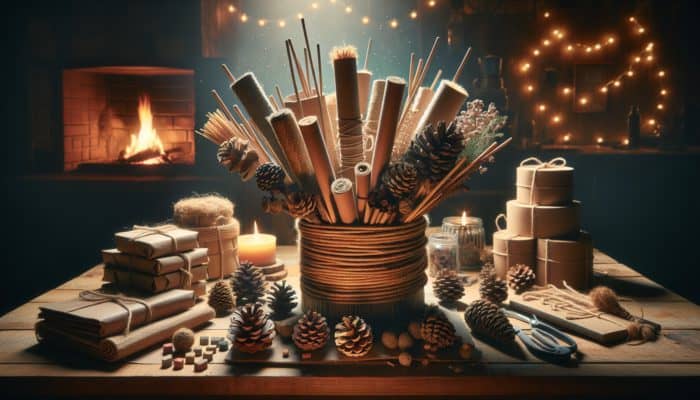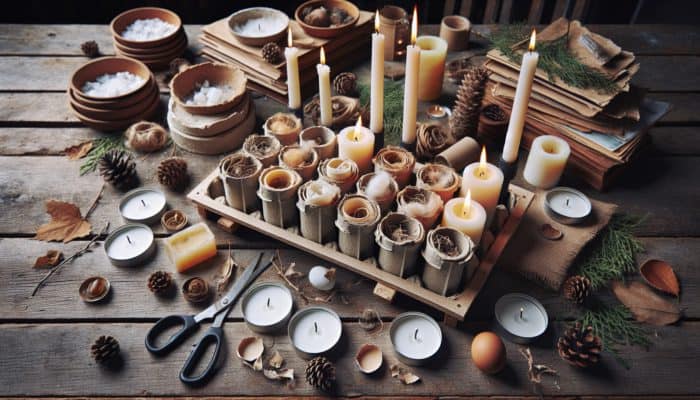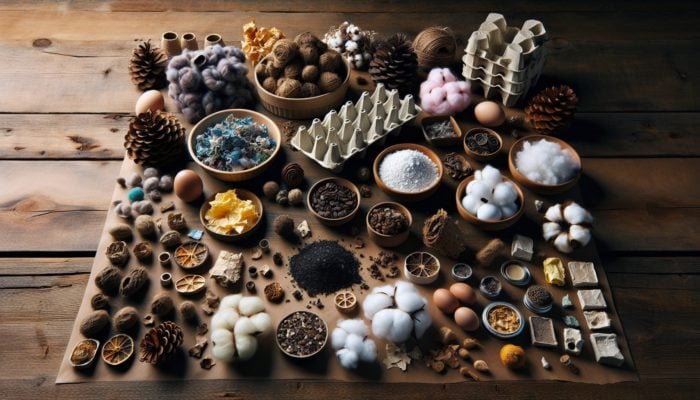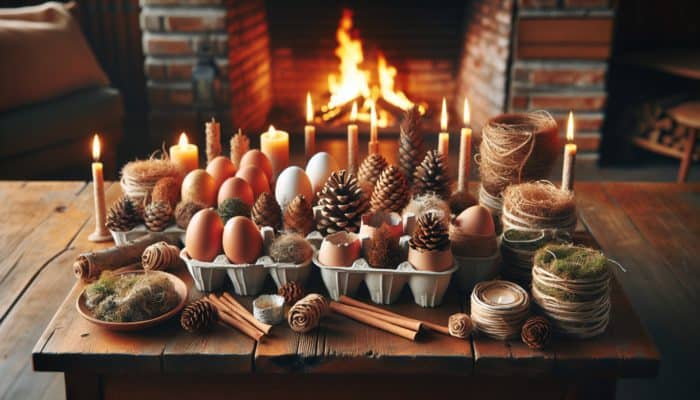Discover the World of Homemade Fire Starters
What Exactly Are Homemade Fire Starters?

Homemade Fire Starters: These are do-it-yourself (DIY) tools specifically designed to facilitate the ignition of fires with ease. Crafted from readily available household items, these fire starters are accessible to anyone who enjoys outdoor pursuits, camping adventures, or simply savouring a warm fire in the comfort of home. The charm of homemade fire starters lies in their remarkable versatility; they can range from uncomplicated wax-and-cardboard creations to intricate blends of various natural materials. Their growing popularity extends beyond functionality; they also resonate with an increasing movement towards self-sufficiency and sustainability in managing fire safely and responsibly.
These fire starters can be utilised in various settings, whether you are lighting a campfire to share tales beneath the twinkling stars or igniting a wood-burning stove on a crisp evening. Their adaptability to diverse environments and conditions makes them suitable for all climates worldwide, from the steamy tropics to the deserts. Each homemade fire starter can be customised to suit the specific needs of the occasion, enhancing your experience of enjoying fire in its myriad forms.
Why Should You Consider Using Homemade Fire Starters?
Choosing to use homemade fire starters offers numerous benefits that transcend mere convenience. To begin with, they are exceptionally cost-effective. By repurposing everyday items, you not only save money but also actively participate in reducing waste. This approach aligns beautifully with the principles of eco-conscious living, as many of the materials can be sourced from items you would typically throw away. For example, dryer lint, leftover wax, and scraps of cardboard can all gain new life as vital components of your fire-starting toolkit.
Furthermore, homemade fire starters can be tailored to meet specific requirements, whether that involves adjusting their size for portability or modifying their burn times for prolonged fires. This level of customisation allows for a deeper connection with the process of fire creation, fostering a sense of accomplishment and mastery over this ancient skill. They also provide a dependable ignition source, particularly useful in challenging conditions where commercial fire starters may not perform optimally. Ultimately, the shift towards homemade solutions represents a return to our roots and an embrace of self-sufficiency in fire management.
How Should You Store Homemade Fire Starters for Best Results?
Proper storage of homemade fire starters is vital to ensure they remain effective and safe to use. To keep these items in optimal condition, consider adhering to a few essential practices. Firstly, they should be stored in a cool, dry place. Exposure to moisture can significantly degrade the materials, diminishing their ignition capability. It is wise to avoid areas prone to humidity or direct sunlight, as heat can compromise the integrity of the components, particularly those based on wax.
A practical approach is to utilise airtight containers for your fire starters. This not only protects against moisture but also keeps unwanted pests at bay. Labelling these containers can add an extra layer of convenience, allowing you to identify them when required quickly. Additionally, it is prudent to keep homemade fire starters out of reach of children and away from heat sources, reinforcing safety as a priority in your storage practices. By adhering to these guidelines, you can ensure that your homemade fire starters are always primed for your next adventure or a cosy evening spent by the fire.
How Can You Make Your Own Homemade Fire Starters?

Creating homemade fire starters is a straightforward process that can be accomplished with just a few common ingredients. You will need materials such as wax (old candles work exceptionally well), cardboard (from boxes or egg cartons), and dryer lint. These components are usually found around the home and can be repurposed, enhancing their appeal as eco-friendly fire-starting solutions.
To make your fire starters, follow these uncomplicated steps:
- Gather your materials: wax, cardboard, and dryer lint.
- Cut the cardboard into small sections or utilise egg cartons for ease of handling.
- In a double boiler, melt the wax until it becomes a liquid.
- Combine the dryer lint with the melted wax.
- Pour the mixture into the cardboard sections or egg carton compartments.
- Allow the fire starters to cool and solidify completely.
- Store them in an airtight container for future use.
By adhering to these steps, you can create effective homemade fire starters that ignite swiftly and burn steadily. The process itself can be a rewarding experience, allowing you to engage creatively with everyday materials while preparing for your next outdoor adventure.
How Long Can You Expect Your Fire Starters to Last?
The longevity of homemade fire starters primarily depends on the materials used and the conditions in which they are stored. When kept properly in a dry, cool environment, they can last for several months or even years. The wax, for instance, acts as a preservative, helping to keep the other materials intact and functional. However, if fire starters are exposed to moisture or high temperatures, their effectiveness may diminish significantly.
It is advisable to inspect your homemade fire starters periodically. If they appear damp or if the materials have degraded, it may be time to replace them. Additionally, understanding the specific components used in your fire starters can provide insights into their durability. For example, starters primarily made of wax will generally outperform those containing higher paper content in terms of shelf life. By maintaining good storage practices and staying mindful of the components, you can ensure that your homemade fire starters remain reliable tools for igniting fires whenever you need them.
Professional Insights on Homemade Fire Starters
What Materials Are Most Effective for Making Fire Starters?

To maximise the effectiveness of your homemade fire starters, selecting the right materials is essential. A variety of common household items can serve as powerful fire igniters. Here are some of the most effective materials for your fire starters:
- Dryer lint: A highly combustible material that ignites quickly and easily.
- Wax: Old candles or paraffin wax act as a binding agent and provide an extended burn time.
- Cardboard: Recycled cardboard provides a sturdy base and an initial flame to help ignite the fire.
- Egg cartons: Useful for holding wax and lint; they also burn well on their own, contributing to the ignition process.
- Cotton balls: When dipped in wax or used alone, they make excellent fire starters.
- Pinecones: Natural options that catch fire easily and continue to burn.
- Used coffee grounds: Can be mixed with wax for an eco-friendly fire starter.
- Paper scraps: Old newspapers or mail can serve as effective ignition sources.
These materials are not only easily accessible but also contribute to a reliable fire-starting experience. Experimenting with various combinations can yield unique fire starters, tailored to your preferences.
How Can You Ensure Safety When Using Fire Starters?
Safety is paramount when utilising homemade fire starters. To ensure you are using them effectively and safely, always adhere to a few essential guidelines. First and foremost, always use fire starters in well-ventilated areas. This minimises the risk of inhaling smoke and ensures good airflow, which is vital for any fire to thrive. Additionally, keep your fire starters away from flammable materials and sources of ignition, as this can help prevent unintended fires.
Having a fire extinguisher close at hand is a critical safety measure. Please familiarise yourself with its location and operation before starting a fire. Never leave a fire unattended, even for a brief moment; vigilance is key to fire safety. Lastly, consider the materials you use for your starters. Some commercial options may contain chemicals that can be harmful. By controlling the ingredients in your homemade starters, you can mitigate health risks and ensure a cleaner burn. Adhering to these safety practices will help create a safe and enjoyable fire-starting experience.
What Expert Tips Can Enhance Your Fire Starter Experience?
Experts emphasise several best practices when it comes to creating and using homemade fire starters effectively. One essential tip is to prioritise the moisture content of your materials. Ensure that all items, particularly materials like dryer lint or paper, are completely dry before use. Wet materials can hinder ignition and reduce efficiency, making your fire-starting efforts more challenging.
Another key aspect is to consider the ratios of your materials. Experts often recommend a blend of wax and combustible materials, such as dryer lint, in a ratio of approximately 1:2. This balance allows for quick ignition while providing a longer burn time. Additionally, incorporating natural accelerants, like small amounts of vegetable oil, can enhance ignition without introducing harmful chemicals—just be sure to use these sparingly.
Real-world examples illustrate the effectiveness of these techniques. For instance, campers in diverse environments around the globe often rely on the adaptability of homemade fire starters, tweaking their formulas based on local conditions. Experimentation is part of the process, and discovering what works best for your specific situation can lead to even greater success in igniting fires.
How Can You Store and Preserve Homemade Fire Starters Effectively?
To maintain the effectiveness of homemade fire starters, proper storage is crucial. Always store them in a cool, dry location to prevent moisture from affecting the materials. Utilising airtight containers can also help to keep moisture at bay while protecting the fire starters from pests or contaminants.
You should check your stored fire starters periodically, especially before planning a camping trip or outdoor activity. If you notice any signs of degradation or moisture, it’s advisable to create new ones rather than risk failure in a critical moment. Labelling containers can aid in organisation, making it easier to identify the contents quickly.
Furthermore, consider maintaining an inventory of your fire starters based on their types and effectiveness. This ensures that you can quickly access the best options for your requirements, whether you are confronted with damp conditions or windy environments. By adopting these storage and preservation strategies, you can maximise the life and reliability of your homemade fire starters.
What Advantages Do Homemade Fire Starters Offer?
Are Homemade Fire Starters Environmentally Friendly?
Homemade fire starters can indeed be eco-friendly, particularly when crafted from recycled or repurposed materials. The environmental impact of commercial fire starters often includes packaging waste and synthetic chemicals that can harm the ecosystem. In contrast, homemade alternatives allow you to embrace a sustainable approach to fire management by using items that would otherwise contribute to landfill waste.
For instance, materials such as dryer lint, leftover wax from candles, and scrap cardboard not only find new life as fire starters but also reduce the overall carbon footprint associated with fire management. Additionally, as you become more aware of your material choices, you can further tailor your fire starters to exclude any harmful additives, opting instead for natural components. This conscious decision-making fosters a positive relationship with nature, aligning with global efforts to encourage sustainability and eco-friendly practices.
Moreover, as homemade fire starters typically do not require extensive industrial processes, they embody a low-impact solution that can contribute to a greener planet. Through this lens, making your fire starters is not just an act of convenience; it becomes a thoughtful, environmentally-friendly choice that aligns with a holistic commitment to sustainable living.
Do Homemade Fire Starters Help Save Money?
Utilising homemade fire starters is undoubtedly a cost-effective approach to managing fire ignition needs. By repurposing items often found around the home, you can significantly reduce expenditure compared to purchasing commercial fire starters. A small investment in ingredients like wax, cardboard, and natural fibres yields a sustainable and practical solution that can produce multiple fire starters at a fraction of the cost of store-bought alternatives.
This DIY approach not only fosters financial savings but also encourages resourcefulness, prompting you to reassess how you perceive everyday materials. Instead of discarding potential fire-starting items, you begin to see their value and usability. Over time, these savings can accumulate, allowing for a more budget-conscious outdoor experience or cosy evenings around the fireplace.
Moreover, as you become adept at creating homemade fire starters, you can adjust your methods to suit your specific needs, further minimising expenses. This process not only enhances your skills but also reinforces the notion that practical knowledge can lead to long-term financial benefits.
Can You Customise Your Fire Starters?
One of the most significant advantages of homemade fire starters is their customisable nature. Unlike commercial options, which are often standardised, you have the freedom to tailor your fire starters to meet your specific requirements, such as size, burn time, and the materials used. This adaptability proves especially valuable in different environments, whether you’re camping in a damp climate or seeking a quick ignition source for a fireplace.
For instance, if you prefer longer burn times, you can experiment with a higher wax-to-lint ratio or incorporate denser materials like sawdust or wood shavings. Conversely, if you need a quick igniter, you might focus on lighter, more volatile materials. This level of personalization extends even further; you can add scents or other natural elements that enhance the experience of your fire, making it more enjoyable.
Additionally, the process of customising your fire starters encourages creativity and resourcefulness. By experimenting with various combinations, you not only discover what works best for your circumstances but also develop a deeper understanding of the dynamics of fire. This knowledge encourages ongoing experimentation and adaptation, enriching your overall experience with fire management across diverse settings.
Research-Backed Insights on Homemade Fire Starters
What Do Studies Reveal About Fire Starters?
Research has demonstrated that homemade fire starters can be more effective than their commercial counterparts, primarily due to the customisable nature of their materials. Studies indicate that when individuals craft their fire starters, they can optimise the composition to enhance ignitability and burn duration. For example, utilising specific ratios of wax and combustible materials can yield significant performance improvements, making homemade options reliable even in challenging conditions.
Moreover, the flexibility inherent in creating your fire starters allows for adjustments based on environmental factors. Campers in various climates have reported higher success rates with homemade fire starters than with commercial products, particularly in damp or windy conditions where consistency is crucial. This adaptability represents a major benefit, reinforcing the notion that understanding the materials and their interactions can lead to greater success in fire management.
These insights highlight the importance of not just the materials themselves but also the way they are combined and utilised. As users gain experience with homemade fire starters, they often become more adept at recognising the variables that impact fire ignition and sustainment. This knowledge translates into a more confident approach to fire management, ensuring effectiveness across diverse environments and conditions.
How Do Homemade Fire Starters Compare to Commercial Options?
When comparing homemade fire starters to commercial options, several key differences emerge that underscore the advantages of the DIY approach. Firstly, cost is a significant factor; homemade versions typically utilise readily available household materials, resulting in lower overall expenses. Conversely, commercial fire starters often carry higher price tags, especially for those marketed as premium products.
In terms of customisation, homemade fire starters excel. Users can tailor their fire starters to suit individual preferences, experimenting with different materials and ratios to create products suited to specific needs. Commercial options, in contrast, tend to offer limited choices, often forcing users to settle for one-size-fits-all solutions that may not meet their requirements.
Moreover, the control over ingredients in homemade fire starters allows users to avoid potentially harmful chemicals commonly found in some commercial products. By choosing natural elements, you can create fire starters that promote cleaner burning and reduced environmental impact. This conscious choice aligns with an increasing global awareness of sustainability and health, making homemade fire starters not only a practical solution but also a responsible one.
What Are the Long-Term Advantages of Homemade Fire Starters?
The long-term advantages of utilising homemade fire starters extend well beyond immediate cost savings. With consistent usage, they contribute to a heightened sense of self-sufficiency and resourcefulness. By mastering the art of crafting your fire starters, you cultivate practical skills that can be beneficial in various situations, whether during camping trips, emergencies, or simply enjoying a fire at home.
Additionally, homemade fire starters can contribute to a reduced environmental impact. By using recycled materials and avoiding the packaging and chemicals associated with commercial products, you play an active role in promoting sustainability. This ecological mindfulness resonates on a global scale, as more individuals seek to minimise their carbon footprints and embrace sustainable practices.
Another long-term benefit is the development of confidence in fire management skills. As you gain experience creating and utilising homemade fire starters, you become more adept at understanding fire dynamics, leading to safer and more effective fire practices. This newfound expertise allows for enjoyable experiences in diverse settings, empowering you to approach fire activities with assurance and skill.
How Can Homemade Fire Starters Improve Safety?
Homemade fire starters can significantly enhance safety, primarily due to the control you have over their composition. Unlike many commercial fire starters that may contain harmful chemicals, creating your own allows you to select natural materials that pose fewer health risks. This focus on safe ingredients leads to cleaner burns and a reduced likelihood of producing harmful smoke or toxic fumes.
Moreover, the customisable nature of homemade fire starters means you can adjust burn times and ignition characteristics to suit specific environments. For instance, being aware that certain materials ignite quickly can prepare you for use in windy or damp conditions, ensuring that you can effectively manage fire risks. This awareness fosters a more responsible approach to fire management, reducing the chances of accidents or uncontrolled flames.
Additionally, the process of making homemade fire starters provides valuable education on fire safety. As you engage with the materials and understand their properties, you become more informed about fire behaviour and the factors that influence ignition and sustainment. This knowledge can translate into safer practices when starting fires, whether in a controlled environment like a fireplace or during outdoor activities. By prioritising safety in your fire-starting efforts, you contribute to a culture of awareness and responsibility in fire management.
Proven Strategies for Homemade Fire Starters
How Can You Enhance the Efficiency of Your Fire Starters?
Improving the efficiency of homemade fire starters involves several actionable strategies that can enhance their performance. First, focus on the ratios of materials you use. A common recommendation is to maintain a balance of approximately 1:2 wax to combustible materials, which ensures an optimal burn time while facilitating quick ignition. Experimenting with different combinations can yield impressive results, allowing you to tailor your fire starters to specific needs.
Incorporating natural accelerants can also significantly boost efficiency. For example, adding a small amount of essential oils or natural oils can enhance ignition without compromising safety. Just be cautious with the quantity, as excessive amounts can lead to uncontrolled flames. Additionally, consider pre-warming wax before mixing it with other materials, as this can improve adhesion and create a more uniform burner.
Real-world scenarios often illustrate the importance of these strategies. Campers in varying conditions, such as those facing damp environments, have found particular success by focusing on material efficiency and composition ratios. By mastering these techniques, you can create fire starters that not only ignite quickly but also burn steadily, proving invaluable across numerous settings.
What Common Mistakes Should You Avoid?
Several common mistakes can undermine the effectiveness and safety of homemade fire starters. First and foremost, using wet materials is a significant error. Moisture can severely reduce ignitability, making it challenging to start fires, especially in adverse conditions. Always ensure that your materials are completely dry before crafting fire starters.
Another frequent pitfall is improper storage. Failing to store fire starters in airtight containers or exposing them to humidity can lead to degradation over time. Regularly inspecting your stored fire starters and replacing any that show signs of wear is crucial to maintaining their effectiveness.
Safety precautions are also vital. Leaving fires unattended, even for a moment, can lead to accidents. Always stay vigilant and ensure you have the necessary safety equipment, such as fire extinguishers, within reach. By addressing these issues proactively and remaining conscious of your practices, you can improve both the safety and effectiveness of your homemade fire starters.
How Can You Use Fire Starters in Various Scenarios?
Homemade fire starters are incredibly versatile, making them suitable for a variety of scenarios. For camping trips, they can be invaluable for igniting campfires, especially in challenging weather conditions. Their ability to burn steadily allows you to build a strong, reliable fire for cooking, warmth, or ambience, whether surrounded by rugged mountains or tranquil lakes.
In urban settings, homemade fire starters can enhance your fireplace experience. They provide a quick and effective way to ignite logs or other fuels, ensuring a cosy atmosphere during chilly evenings. Additionally, they are handy during emergencies where quick ignition is crucial, such as during power outages or natural disasters.
The adaptability of homemade fire starters extends even further. You can customise them to fit specific needs, such as creating smaller, portable versions for backpacking or larger, more robust starters for outdoor cooking setups. Regardless of the context, having quality homemade fire starters on hand ensures you are always prepared to enjoy the warmth and comfort of fire, no matter the environment.
Maintenance and Care for Your Homemade Fire Starters
How Often Should You Replace Your Fire Starters?
Determining when to replace homemade fire starters is essential for ensuring their ongoing effectiveness. The general guideline is to inspect your fire starters regularly, particularly if they have been stored for extended periods. If they show signs of dampness, degradation, or if the materials lose their structural integrity, it’s time to create replacements.
In humid environments, you may find that fire starters degrade faster due to moisture exposure, necessitating more frequent replacements. Conversely, those stored in cooler, drier areas might last longer. Nevertheless, always err on the side of caution; if you’re ever uncertain about the condition of your fire starters, it’s best to make new ones rather than risk failure when you need them most.
By developing a routine of inspecting and replacing your homemade fire starters, you not only maintain their effectiveness but also ensure a safe fire-starting experience. This proactive approach will ultimately enhance your confidence and preparedness in managing fire, regardless of the setting.
What Are the Best Practices for Storing Fire Starters?
Maintaining the effectiveness of homemade fire starters requires adherence to best storage practices. First and foremost, always store them in airtight containers to protect them from moisture and pests. Glass jars, plastic bins, or resealable bags are excellent options for keeping your fire starters safe from environmental factors.
It’s also wise to label your containers for easy identification. This can help you quickly locate the desired fire starters when preparing for outdoor activities or cosy nights indoors. Additionally, consider keeping your fire starters in a cool, dry location, away from direct sunlight and heat sources, which can compromise their materials over time.
Regularly checking the condition of stored fire starters is another integral practice. This proactive approach helps you catch any signs of moisture or degradation early, allowing for timely replacement if necessary. By incorporating these best practices into your routine, you can ensure your homemade fire starters remain effective and ready for use when needed.
Can You Reuse Your Homemade Fire Starters?
Yes, certain homemade fire starters can be reused if they are not fully consumed. For example, if you’ve used cotton ball fire starters, you may find they still contain residual materials that can be reignited. However, it is essential to assess their condition beforehand. If they are still dry and intact, you can reassemble or repurpose them for future use.
When reusing fire starters, always ensure they are stored properly between uses. Keeping them in airtight containers can help maintain their effectiveness, preventing moisture exposure and degradation over time. Should you decide to reuse a fire starter, make sure to monitor its performance and replace it if it shows signs of wear or dampness.
Ultimately, reusing homemade fire starters not only maximises their lifespan but also aligns with eco-friendly practices that prioritise sustainability. It reinforces the idea that every element in your fire-starting toolkit can be of value multiple times, making the most of your resources and contributing to a greener approach to fire management.
Frequently Asked Questions
What are the best materials for crafting homemade fire starters?
The best materials for homemade fire starters include dryer lint, wax, cardboard, egg cartons, cotton balls, pinecones, and paper scraps. This variety ensures effective ignition and combustion.
How should I store homemade fire starters safely?
Store homemade fire starters in a cool, dry place within airtight containers. This prevents moisture accumulation and keeps them safe from pests.
Can homemade fire starters be effective in wet conditions?
Yes, homemade fire starters can perform well in wet conditions, particularly if made with moisture-resistant materials and properly stored before use.
How long do homemade fire starters typically last?
When stored correctly, homemade fire starters can last for several months to years. Their longevity depends on the materials used and the storage conditions.
Are homemade fire starters safe to use?
Yes, homemade fire starters can be safe if crafted from natural materials and utilised in well-ventilated areas. Proper safety precautions should always be observed.
Can I customise my fire starters to meet specific needs?
Absolutely, homemade fire starters can be customised to adjust size, burn time, and materials based on your specific requirements or preferences.
What are some common mistakes to avoid when working with fire starters?
Common mistakes include using wet materials, improper storage, and neglecting safety practices. These can reduce effectiveness and increase risks.
How can I improve the efficiency of my fire starters?
You can enhance fire starter efficiency by optimising material ratios, adding natural accelerants, and ensuring all components are thoroughly dry.
How often should I inspect my homemade fire starters?
Inspect homemade fire starters regularly, especially before use, to check for moisture, degradation, or any signs of wear that may require replacement.
Is it possible to reuse homemade fire starters?
Yes, some homemade fire starters can be reused if they remain intact and dry. Monitor their condition before reusing to ensure effectiveness.
Discover more insights on our platform!
Knife Maintenance Guide: Essential Tips for Longevity
Understanding the Essential Role of Regular Knife Maintenance Why Is Regular Knife Maintenance Crucial for Your Kitchen? Knife Maintenance Guide: Consistent care for your knives is pivotal in maintaining their performance and longevity. Regular maintenance keeps your knives sharp, effective, and safe for everyday culinary tasks. A well-cared-for knife not only enhances your cooking experience but also significantly […]
Earthquake-Proofing Home: Essential Tips and Techniques
Comprehensive Guide to Understanding Earthquake Risks What Are the Primary Causes of Earthquakes? Earthquake-Proofing Home: Earthquakes primarily result from the dynamic movement of tectonic plates situated beneath the Earth’s surface. These geological plates are in a constant state of flux due to various geological processes. When these plates collide, slide past one another, or drift […]
Blizzard Heat Retention: Essential Tips for Cold Weather
Comprehensive Guide to Maximising Heat Retention During Blizzards What Exactly Is Blizzard Heat Retention? Blizzard Heat Retention: Blizzard heat retention refers to a variety of methods and technologies specifically developed to maintain warmth during extreme winter storms, particularly severe blizzards. These intense snowstorms can lead to dangerously low temperatures and fierce winds, making it crucial to […]
Water Filter Maintenance: Essential Tips and Tricks
Significance of Consistent Maintenance for Water Filters Why is Consistent Maintenance Essential for Water Filters? Water Filter Maintenance: Maintaining your water filter is not just a recommendation; it’s a critical requirement for the overall health and efficiency of your household. Engaging in regular maintenance guarantees that your filter operates at peak performance, extends its lifespan, […]








I find the concept of homemade fire starters to be truly fascinating, especially given the current push towards sustainability and self-sufficiency. There’s something special about being able to create your own tools from items right in your home—it’s a little act of empowerment.
The idea of creating homemade fire starters really does connect to a larger movement towards sustainability and self-sufficiency. It’s interesting to think about how something as simple as starting a fire can be tied to our desire for independence and resourcefulness. When we craft fire starters from everyday materials—like kitchen scraps or old newspapers—we’re not just reducing waste; we’re also rediscovering skills that many of us might have lost over time.
I completely agree with the idea that homemade fire starters tap into a sense of empowerment and self-sufficiency. It’s amazing how small acts like this can reflect larger values around sustainability. It reminds me of how people used to rely on nature and their surroundings to create tools and solutions long before modern conveniences took over.
Your exploration into homemade fire starters truly resonates with the growing movement towards sustainability. I’ve recently started making my own fire starters using leftover dryer lint and cardboard egg trays, and it’s a delightful way to repurpose materials that would otherwise be discarded. The ease of igniting a fire with just a few of these DIY tools has transformed my camping experience, making it not just convenient but also a fun project to do with friends and family.